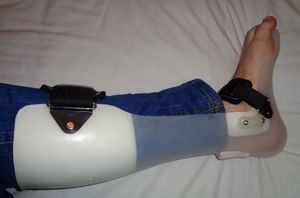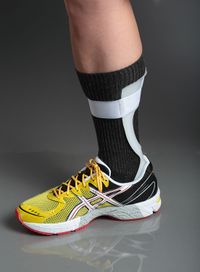Foot drop
Original Editor - Abbey Wright
Top Contributors - Abbey Wright, Lokiru Paul, Kim Jackson, Admin and Lucinda hampton
Introduction[edit | edit source]
Foot drop is caused by disruption to the common peroneal nerve which controls active dorsiflexion of the ankle leading to a lack of heel strike during gait hence the term foot drop. Image to R shows common brace (AFO) for foot drop.
Clinically Relevant Anatomy[edit | edit source]
The common peroneal nerve is the smaller and terminal branch of the sciatic nerve which is composed of the posterior divisions of L4, 5, S1, 2. The nerve can be palpated behind the head of the fibula and as it winds around the neck of the fibula.[1]
Commonly, with damage to the common peroneal nerve, there will be weakness of tibialis anterior and other key dorsiflexors of the foot.
Mechanism of Injury / Pathological Process[edit | edit source]
The common peroneal nerve is in a particularly vulnerable position as it winds around the neck of the fibula. It may be damaged at this site by:
- Trauma or injury to the knee
- TKA[2]
- Neurological disorders i.e. stroke[3]
- Compression of the fibula head during surgery e.g. tourniquet[2]
- Fracture of the fibula
- Fracture to tibial plateau[4]
- Patellar dislocations (33% chance of nerve damage)[5]
- Ankle inversion injury[6]
Clinical Presentation[edit | edit source]
Typical presentation of foot drop can be noted when testing the foot and ankle in isolation, however, in a clinical setting, it may be identified initially through gait assessment.
Foot and Ankle[edit | edit source]
- When testing the foot and ankle a positive test for foot drop is NO active dorsiflexion in a non weight bearing position.
- It is important to test passive ROM to ensure the ankle is not stiff.
- See foot and ankle examination page for a full assessment of the foot and ankle.
Gait Assessment[edit | edit source]
- Gait should be assessed in any clinical setting.
- Foot drop gait can manifest in different ways varying from patient to patient.
- Some patients may increase the amount of hip flexion they produce on the effected side therefore, clearing the floor more effectively:
- [7]
- Other patients may circumduct the hip and drag the forefoot along the floor:
Pain[edit | edit source]
- Neurogenic pain can be experienced from damage to the common peroneal nerve.
- This pain can be present over the lateral aspect of the knee as well as the dorsal part of the foot.
- Sensory changes can also be experienced indicating nerve damage to the therapist.[9]
Diagnostic Procedures[edit | edit source]
- Subjective History: emphasis on any knee trauma, recent spinal/peripheral limb surgery or family history of neurological disease
- Assessment of ankle dorsiflexion
- Neurological exam[9]
- Gait assessment
- Electromyography (EMG) / Nerve conduction studies[10][6]
Outcome Measures[edit | edit source]
- Foot and ankle disability index
- Functional gait analysis
- Stanmore assessment of foot drop[11]
- Hand dynamometry of the dorsiflexors in the foot using the Oxford scale
Management / Interventions[edit | edit source]
Following palsy of the common peroneal nerve, the main residual symptom can be foot drop due to the disruption to L4/5 muscle groups which perform dorsiflexion.
This has been shown to resolve in two-thirds of patients by one-year post-injury. [2]
Pain should also be addressed if the patient is experiencing neuropathic pain by use of appropriate analgesia. [9]
Splinting[edit | edit source]
One way to improve function while the foot drop resolves is the use of splinting.
A solid ankle-foot orthoses (AFO) or foot-up splint can be used to keep the foot in plantar-grade.
These work to increase the amount of dorsiflexion the foot is held in during gait and can prevent falls as the toes do not get caught on the floor.
Exercise[edit | edit source]
Physiotherapy interventions normally are focused on graded exercises to encourage active dorsiflexion and muscle recruitment. These exercises have been shown to prevent atrophy and speed up recovery but more research is needed.[2]
In neurologically impaired patients such as Charcot‐Marie‐Tooth disease improved with strengthening exercises to tibialis anterior, however, other neurological diseases like muscular dystrophy strength training was not found to be effective at reducing the foot drop. [12]
Preventing contractures and stiffness is also an important maintenance goal of physiotherapy as this is likely in neurological disease patients more so than after trauma to the knee.
Electro-stimulation of the affected muscle groups has also been shown to improve recovery times.[2]
Surgery[edit | edit source]
Direct repair of the common peroneal nerve is possible for surgical intervention however, this has been shown to have poor outcomes with residual foot drop leading to further surgery.[13]
In extreme cases tibialis posterior can be transposed to regain active dorsiflexion by using the tendon not innervated by the common peroneal nerve, this surgery has been shown to be more successful than nerve repair.[4][13][11]
Surgery has been shown to be successful at improving active dorsiflexion strength and reduced use of AFOs.[14]
Differential Diagnosis[edit | edit source]
- L5 radiculopathy[10]
- Upper motor neuron lesion
- Chronic/persistent pain[15]
- Sciatic nerve injury[9]
Resources[edit | edit source]
References[edit | edit source]
- ↑ Palastanga N & Soames R Anatomy and Human Movement, Structure and Function. 6th ed. China: Elsevier(Churchill Livingstone) Limited; 2012.
- ↑ 2.0 2.1 2.2 2.3 2.4 Park JH, Restrepo C, Norton R, Mandel S, Sharkey PF, Parvizi J. Common peroneal nerve palsy following total knee arthroplasty: prognostic factors and course of recovery. The Journal of arthroplasty. 2013 Oct 1;28(9):1538-42
- ↑ Everaert DG, Stein RB, Abrams GM, Dromerick AW, Francisco GE, Hafner BJ, Huskey TN, Munin MC, Nolan KJ, Kufta CV. Effect of a foot-drop stimulator and ankle–foot orthosis on walking performance after stroke: a multicenter randomized controlled trial. Neurorehabilitation and neural repair. 2013 Sep;27(7):579-91.
- ↑ 4.0 4.1 Baima J, Krivickas L. Evaluation and treatment of peroneal neuropathy. Current reviews in musculoskeletal medicine. 2008 Jun 1;1(2):147-53.
- ↑ Henrichs A. A review of knee dislocations. Journal of athletic training. 2004 Oct;39(4):365.
- ↑ 6.0 6.1 Brief J M, et al. Peroneal Nerve Injury with Foot Drop Complicating Ankle Sprain A Series of Four Cases with Review of the Literature. Bulletin of the NYU Hospital for Joint Diseases. 2009;67(4):374-7
- ↑ Steppage Gait. Judy Mishriki Available from: https://www.youtube.com/watch?v=TijuPg8_JhY [last accessed 02/09/2013]
- ↑ Alaine Wambe MD. Right slap gait/steppage gait/foot drop in a post operative patient. Available from: https://www.youtube.com/watch?v=EjPUpKUbZSg [last accessed 11/03/2019]
- ↑ 9.0 9.1 9.2 9.3 Baima J, Krivickas L. Evaluation and treatment of peroneal neuropathy. Current reviews in musculoskeletal medicine. 2008 Jun 1;1(2):147-53.
- ↑ 10.0 10.1 Masakado Y, Kawakami M, Suzuki K, Abe L, Ota T, Kimura A. Clinical neurophysiology in the diagnosis of peroneal nerve palsy. The Keio journal of medicine. 2008 Jun 25;57(2):84-9.
- ↑ 11.0 11.1 Lingaiah P, Jaykumar K, Sural S, Dhal A. Functional evaluation of early tendon transfer for foot drop. Journal of Orthopaedic Surgery. 2018 Sep 19;26(3):2309499018799766.
- ↑ Sackley C, Disler PB, Turner‐Stokes L, Wade DT, Brittle N, Hoppitt T. Rehabilitation interventions for foot drop in neuromuscular disease. Cochrane Database of Systematic Reviews. 2009(3).
- ↑ 13.0 13.1 Özkan T, Tuncer S, Ozturk K, Aydin A, Ozkan S. Tibialis posterior tendon transfer for persistent drop foot after peroneal nerve repair. Journal of reconstructive microsurgery. 2009 Apr;25(03):157-64.
- ↑ Hove LM, Nilsen PT. Posterior tibial tendon transfer for drop-foot: 20 cases followed for 1–5 years. Acta Orthopaedica Scandinavica. 1998 Jan 1;69(6):608-10.
- ↑ Brewer RB, Gregory AJ. Chronic lower leg pain in athletes: a guide for the differential diagnosis, evaluation, and treatment. Sports Health. 2012 Mar;4(2):121-7.








